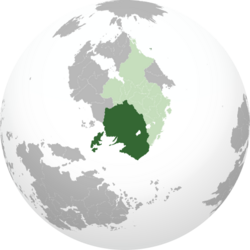Ardmore
This article is a work-in-progress because it is incomplete and pending further input from an author. Note: The contents of this article are not considered canonical and may be inaccurate. Please comment on this article's talk page to share your input, comments and questions. |
Ardmori Cooperative Ardmóri Comarchun (Garán Gaelic) | |
|---|---|
Motto: Your motto, often in another language ("Your motto in English") | |
Anthem: Your song | |
 Location of XXX (dark green) In XXX (gray) | |
| Capital and largest city | Dunvál |
| Official languages | Garán Gaelic |
| Demonym(s) | Ardmori |
| Government | Your government type |
• Your head of state | Joe Blow |
• Your head of government if applicable, otherwise a legislative leader | Jane Blow |
• A legislative leader of a different house, if applicable | Georgw Blow |
| Your upper house | |
| Your lower house | |
| Establishment | |
• An event | A date |
| Population | |
• Estimate | Your population |
| GDP (nominal) | estimate |
• Total | Your GDP = GDPPC x Population (This is calculated for you after first entry) |
• Per capita | Your GDP PC |
| Currency | Your Currency |
Ardmore (Gaelic: Ardmór), officially the Ardmori Cooperative, is a country consisting of several islands off the western shore of Levantia in the Odoneru Ocean.
The people of Ardmore, known as Ardmoris, are considered members of the Garán people, sharing this identity with the people of Carolina. Much of their heritage results from the blending of Gaelic and Gothic cultural traditions that occurred in Carolina and adjoining areas in the years leading up to the collapse of Great Levantia. Garáns are thought to have invaded Ardmore and settled it in the mid-6th century, though no unified Garán polity emerged on the main island of Great Ardmore; loose alliances of mainland cities and tribes were formed with the newly established Garán cities and tribes on the island. The area was briefly incorporated into the early Levantine Empire and subsequent Southern Kingdom of the Levantines, but fell out of Carolina's orbit and subsequently became an independent Christian kingdom in 1004. Its people retained cultural and economic ties with the mainland while beginning to spread out throughout the remaining islands of what became known as the Ardmori Archipelago, settling New Ardmore by the late 11th century and displacing the Gothic people living there.
Etymology
Geography
History
Pre-Kingdom history
Prior to the arrival of the Garán people to Great Ardmore, a wide variety of people are thought to have lived on the island and the adjoining parts of the archipelago. Adonerii cities were established on the island by 600 BC, representing the furthest northern outposts of that civilization. The Adonerii cities were relatively sparsely populated compared to the rest of the Latinic world, and few historical records survive from them. From what records do exist, historians believe the islands were mostly populated by a Paleo-Levantine people likely known as the Ardmen, from which the islands get their name. Very little is known about the Ardmen, though they continued to inhabit the interior of the island when it became a tributary of Great Levantia in ca. 50 BC. Great Levantine influence on the island was limited, with the few urban centers largely sending tribute to Urceopolis with little to no Levantine military influence on the island. Like much of the area, the earliest peoples of Great Ardmore - both Latinic and Ardmen - relied on fishing. The islands were not especially prosperous and were not along the main, Crotona-based trade route between Sarpedon and Levantia, and were considered a backwater during antiquity.
As Great Levantia entered terminal decline, the region of what is today Carolina became a pourous frontier which saw the emergence of the Garán people as a blend of invading Gothic people and indigenous Gaelic people. Continued invasions of Goths lead many borderlanders to seek new lands elsewhere, and the first Garán warbands are thought to have arrived in Great Ardmore in the late 400s in small numbers, serving as mercenaries by the coastal cities against the Ardmen tribes in the interior. A major invasion of the island by Garáns occurred at some point in the mid-6th century, with the lightly populated island easily overcome by the numerous mainland invaders. The Ardmen and Latins, long thought by historians to have been slaughtered, were likely incorporated into the new social system, and many Ardmoris today are thought to have some descent from Ardmen.

